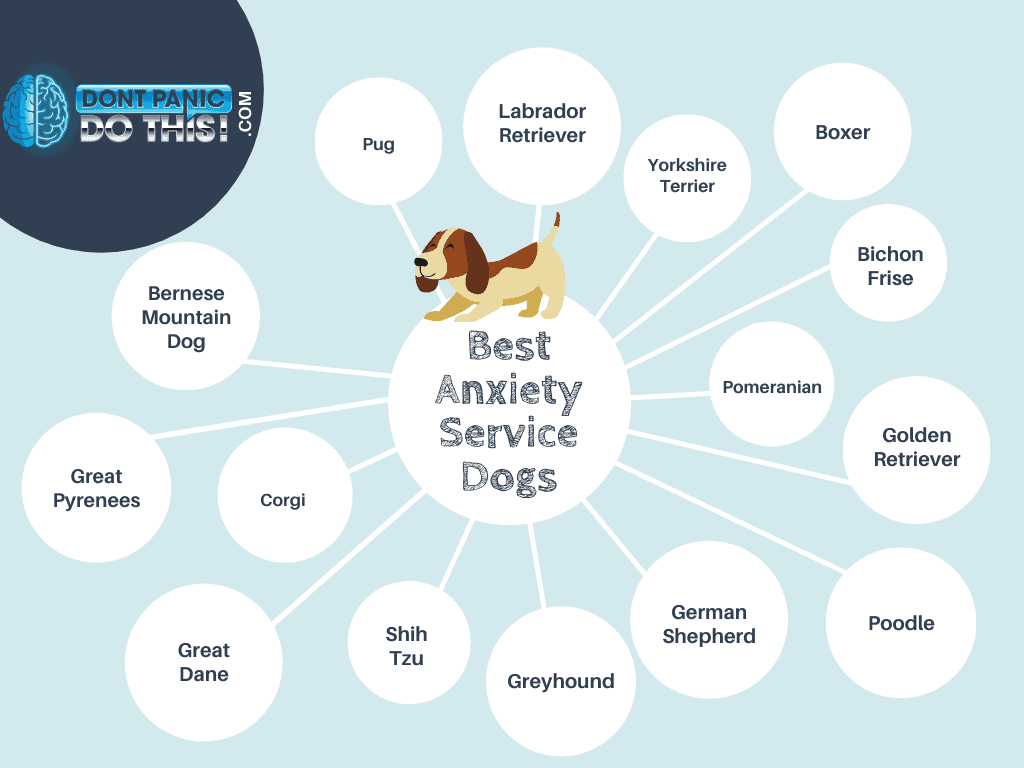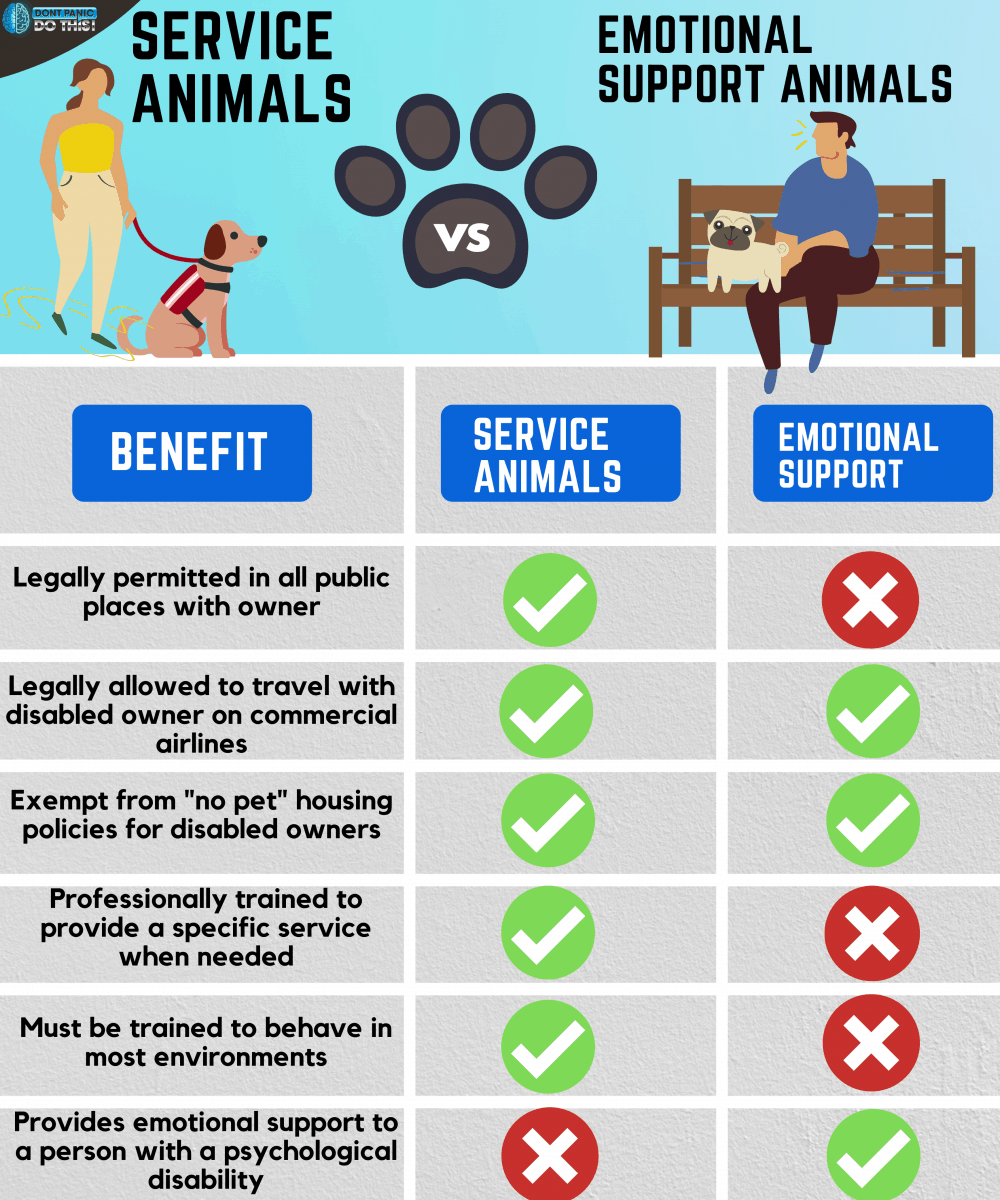Most of us can relate to the feeling of seeing a golden good boy in a “Service Dog” vest and wanting to pet them but knowing we shouldn’t. A service dogs serves an important role in assisting its owner with a disability. So, how can you get a service dog for anxiety?
To get a service dog for anxiety, an individual's anxiety must be severe or debilitating in nature. While the ADA does not mandate a recommendation letter from a licensed mental health professional or doctor to use a service dog in public places, such documentation can be useful in contexts like housing or air travel where different regulations apply.
You will also need to be able to provide a stable home environment, as well as the ability to consistently care for and train your service dog.
If you’re struggling with a physical disability or a psychiatric condition, you may qualify for a service animal. But, how might a service dog help with your anxiety? How would you go about getting a service dog? And how do these differ from emotional support animals for anxiety?
Keep reading and answer all these questions and more!
What is a Service Dog?
Before we dive right in, let’s clarify exactly what a service dog is.
According to the Americans with Disabilities Act (ADA):

“Service animals are defined as dogs that are individually trained to do work or perform tasks for people with disabilities. Examples of such work or tasks include guiding people who are blind, alerting people who are deaf, pulling a wheelchair, alerting and protecting a person who is having a seizure, reminding a person with mental illness to take prescribed medications, calming a person with Post Traumatic Stress Disorder (PTSD) during an anxiety attack, or performing other duties. Service animals are working animals, not pets. The work or task a dog has been trained to provide must be directly related to the person’s disability. Dogs whose sole function is to provide comfort or emotional support do not qualify as service animals under the ADA.
This definition does not affect or limit the broader definition of “assistance animal” under the Fair Housing Act or the broader definition of “service animal” under the Air Carrier Access Act.
Some State and local laws also define ‘service animal’ more broadly than the ADA does.”
In other words, a service dog is a dog that is specifically trained to perform disability-related tasks for an owner with a disability. Service dogs are protected by the ADA, so a disabled owner can legally bring their service dog just about anywhere with them, bypassing typical pet policies. A service dog differs from an emotional support animal because of its training; its job is to assist its owner in a capacity that goes beyond emotional comfort alone. We’ll get into the differences between service animals and emotional support animals in greater detail later.
How Does a Service Dog Help with Anxiety?
Generally speaking, service dogs can provide a vast range of services for their owners. Guide dogs, hearing dogs, seizure response dogs, diabetic alert dogs, mobility assistance dogs, allergy detection dogs, autism support dogs, and psychiatric support dogs are the 8 most common categories of service dogs. In this article, we’ll be focusing mainly on psychiatric service dogs, as they are typically the most relevant type of service dog for people with anxiety.
Anxiety and anxiety disorders can vary greatly from person to person, and can be as individual as a fingerprint. The service you actually require from an anxiety service dog can also vary greatly. Theoretically, a service dog can be trained to assist with anxiety in just about any way you could imagine or require.
Some of the most common ways how service dogs can help with anxiety include:
- Fetching water, medication, or a comfort item for their owner
- Bringing their owner a phone during an anxiety attack, to call a trusted friend or therapist
- Alerting someone nearby that their owner is in distress
- Keeping strangers distanced from their owner when their owner needs space
- Distracting their owner to help end a panic attack or soothe anxiety
- Comforting their owner via physical contact and deep pressure therapy
- Informing the owner when somebody is waiting for them around a corner (PTSD)
If these benefits of having psychiatric service dog sound like benefits that could help you manage your anxiety, it may be worthwhile to look into getting a service dog for anxiety.
How to Get a Service Dog for Anxiety
Do I Qualify for a Service Dog for Anxiety?
To obtain a service dog for anxiety, the individual must have a disability, in this case, an anxiety disorder that significantly limits one or more major life activities. Many people with anxiety disorders have conditions that are too mild to be eligible.
If this is the case for you, no worries! Even if you do not meet the criteria or severity level required to justify a service animal, you can likely still qualify for an emotional support animal. Emotional support animals can be great alternatives to service animals. While they are not specifically trained to assist you with your disorder, they can still help to provide many people with therapeutic emotional support and comfort just by being present. All that’s required to qualify for an emotional support animal is a letter from a licensed mental health professional. We’ll get into emotional support animals more in a bit.
Best Service Dog Breeds for Anxiety
When deciding on the best service dog breed for anxiety, there are a few factors you’re going to need to consider. Let’s start by listing a few of the best service dog breeds for anxiety:




- Labrador Retriever
- Golden Retriever
- German Shepherd
- Boxer
- Pomeranian
- Bichon Frise
- Poodle
- Bernese Mountain Dog
- Yorkshire Terrier
- Pug
- Greyhound
- Corgi
- Great Pyrenees
- Great Dane
- Shih Tzu
These are just some of the dog breeds well suited as anxiety service dogs, so don’t take offense if your pooch’s breed didn’t make the list! Most of these dog breeds are well-known for their loyalty, intelligence, and temperament. Of course, dog traits vary from breed to breed, so it’s important to consider exactly what tasks will be required of them as a service animal.
If you’re feeling a bit overwhelmed when choosing a service dog breed, you can weed out the list considerably by starting with a size. For both service animals and emotional support animals, the size of your pet is going to determine what services they’re able to provide and where you can physically bring them.
While your service dog is legally permitted to enter any establishment with you, having a larger dog could pose physical difficulties in some places. A smaller dog, on the other hand, might be easier to bring along with you from place to place, but they may not be able to provide all of the services that a larger dog might provide (pulling a wheelchair, etc.). Would it be more helpful for you to have a large dog than you can hug, or a smaller dog that could hop up on your lap? These are all factors that should be considered when choosing the best service dog breed for your anxiety.
Where to Get a Service Dog for Anxiety
The next step will be actually obtaining a service dog. For most people, the fastest and easiest way to do this is finding a program that professionally trains psychiatric service dogs, and purchasing one through them. Or, you could work with a professional dog training company that can help you to train your own dog from home. Alternatively, you do have the right to forego professional training and train a dog yourself, but this can be difficult if you are not experienced in dog training. In order to have your service dog fully qualified to enter any public space with you, it will need to pass a Public Access Test (PAT).
How Much Does a Service Dog for Anxiety Cost?
If you decide to buy a pre-trained service dog for anxiety, it will likely cost somewhere between $20,000-30,000. This seems to be the average cost once temperament testing, veterinarian expenses, food, and service training are all accounted for.
It’s also important to keep in mind that just because your doctor or mental health professional has cleared you for a service dog, you are not necessarily guaranteed to be sold one. There are various companies online that you can apply for a service dog through, and each one will put you through their own sort of application process.
These companies typically vet all potential clients to make sure the dog is going to a safe and happy home. These criteria can vary from company to company, but typically they want to see that you are able to provide a safe, stable, and loving environment for the dog, and that you have the finances to care for the dog over the next 12 years or so. Some of these companies will specialize in certain types of training; others may have age requirements or other pre-requisites you must meet before obtaining a psychiatric service dog from them.
The best company to go through is going to depend on your unique needs, your location, and how far you are willing to travel. I recommend a quick internet search to see what options you may have nearby, and choosing one based on their reviews. Just make sure that it’s a service dog you’re applying for if that’s what you need, as opposed to a “therapy animal” or “emotional support animal.”
Training a Service Dog for Anxiety
Some service dog training companies may offer temperament testing followed by the ability for you to train your dog from home. This could potentially be a better option for those who are trying to save a bit of money as opposed to buying a dog fully trained.
This can be a completely legitimate option, as long as the program is helping you to train the basic skills and the public access skills required for your dog to pass the Public Access Test. If your dog can’t pass the Public Access Test, you can’t claim the legal right to bring it into any public space with you.
How to Train Your Own Dog to Respond to Your Anxiety
If you’re feeling confident, ambitious, or just have a lot of experience training animals, you do have the option to bypass professional training and train a service dog yourself. Typically, it is not recommended to try this with a dog that has already grown used to being a pet; the life of a traditional pet and that of a service dog can differ considerably, and you know what they say about teaching an old dog new tricks.
While the ADA does not mandate a formal Public Access Test for service dogs, ensuring your dog behaves appropriately in public settings can provide peace of mind and attest to its readiness. If your primary need is for your dog to assist with specific tasks related to your disability in various environments, consistent training and behavior assessment are crucial.
However, if your primary goal is to have an animal for emotional support and comfort without the need to bring it into all public spaces, the designation of "emotional support animal" might be more appropriate. It's essential to understand the distinctions and rights associated with service dogs and emotional support animals.
The Difference Between a Service Animal and an Emotional Support Animal (ESA)




We’ve discussed service animals quite a bit... now what about emotional support animals?
The main benefit of a service animal is that you can bring it with you just about anywhere you go. Restaurants, airlines, and landlords, are all legally required by the ADA to allow your service dog to accompany you at no additional cost. The caveat to this is that, in order for you and your service dog to enjoy these privileges, your service dog should be professionally trained to provide a specific service when needed, and they must be trained to behave in such an environment.
Really, the only time restrictions are placed on service dogs is if it would be unsafe to accommodate the dog. For example: your service dog can go to Disney World with you, but it can’t ride Rock ‘n’ Rollercoaster.
Emotional Support Animals enjoy some of these same benefits, but not all. Emotional Support Animals are exempt from “no pet” housing policies. They are not, however, automatically permitted into any public space with their owner. As of February 2021, commercial airlines are no longer required to allow emotional support animals onboard at no additional cost to their owners. Many airlines now regard emotional support animals as pets, which may be allowed onboard (depending on the species) for an additional pet fee. Individual businesses may accept or deny access to emotional support animals at their own discretion. So, you can’t quite take an emotional support animal anywhere that a service animal can go, but an emotional support animal does not need to be specially trained to provide a service or behave in a wide variety of environments*; all they need to do is provide you with emotional support.
*Something important to mention: Although your emotional support animal doesn’t need to be trained to behave in all environments, this is not an excuse for poor behavior. If your dog is actively snapping, growling, or barking at people on a flight, you can probably expect to be removed from the plane.
Can You Get an Emotional Support Dog for Anxiety?
Far more people are eligible for an emotional support animal than for a service animal. Emotional support animals are often the appropriate choice for milder cases of anxiety. If you require a physical task to be completed to assist you with your anxiety, you might need a service dog. If you only require some emotional support for your anxiety, an emotional support animal could be sufficient.
In order to be approved for an emotional support animal, you only require a letter from your medical doctor or licensed mental health professional.
Because an emotional support animal does not require any special training, you can pretty much choose any of your current pets to designate as an emotional support animal.
What about Therapy Animals?
We won’t be going into therapy animals deeply in this article, but to give you a quick explanation: A therapy animal is an animal that is trained to provide emotional comfort and support to many people, rather than just one. These animals must be trained to behave in any a wide variety of environments, but do not perform specific tasks like service animals do. Additionally, they are not granted special access to public spaces the way service animals are. A common example of a therapy animal is a dog and trainer duo that briefly visits many patients within a hospital cheer them up and put them in a good mood. If you’re solely looking for a dog to help you with your anxiety, this probably is not what you’re looking for.
Possible Alternatives to Service Dogs for Anxiety
Service dogs or emotional support animals can be a wonderful and versatile solution to anxiety. But they can also be expensive and require quite a bit of care. For these reasons, they may not be the best solution for everyone.
Some potential alternatives to service dogs for anxiety:
Stuffed Animal for Anxiety
Some people may find it comforting to carry around a stuffed animal for anxiety. A stuffed animal can become a comfort item for some, potentially helping them to soothe their stress and calm down during an anxiety attack. People often attach significant emotional and sentimental value to stuffed animals, and may even start to personify them. Having something soft and available to hold, such as a stuffed animal, might offer comfort in a way similar to emotional support animals.
Weighted Blanket for Anxiety
One useful trick that psychiatric service dogs are often taught is deep pressure therapy. This can involve laying across their owner to provide a sense of comfort and security through tactile stimulation. If a service animal is not an option for you, a weighted blanket may be able to offer similar benefits to you to help decrease your stress and anxiety. Many people who use weighted blankets for anxiety report feeling less stressed and nervous under them. You can check out the most popular weighted blankets here.


